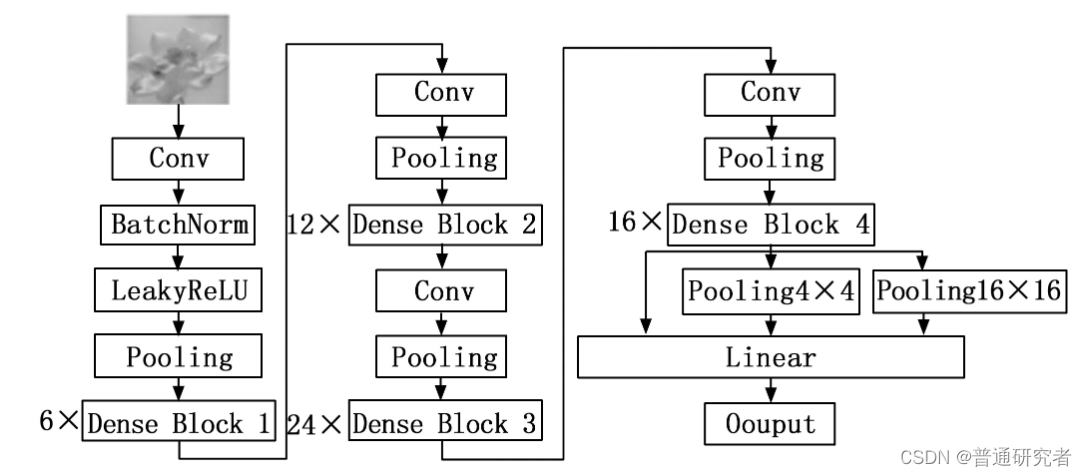最近,我在做多分类问题。在针对基模型的选择中,我使用了DenseNet作为基本模型。我在阅读论文时,遇到了一种改进方式:

如上图所示,在全连接层之前引入SPP模块:

代码如下:
SPP模块代码:
class SpatialPyramidPooling(nn.Module):
def __init__(self, pool_sizes: List[int], in_channels: int):
super(SpatialPyramidPooling, self).__init__()
self.pool_sizes = pool_sizes
self.in_channels = in_channels
self.pool_layers = nn.ModuleList([
nn.AdaptiveMaxPool2d(output_size=(size, size)) for size in pool_sizes
])
def forward(self, x: Tensor) -> Tensor:
pools = [pool_layer(x) for pool_layer in self.pool_layers]
# Resize the output of each pool to have the same number of channels
pools_resized = [F.adaptive_max_pool2d(pool, (1, 1)) for pool in pools]
spp_out = torch.cat(pools_resized, dim=1) # Concatenate the resized pools
return spp_out
加入SPP代码后的DenseNet网络完整如下:
import re
from typing import List, Tuple, Any
from collections import OrderedDict
import torch
import torch.nn as nn
import torch.nn.functional as F
import torch.utils.checkpoint as cp
from torch import Tensor
class _DenseLayer(nn.Module):
def __init__(self, input_c: int, growth_rate: int, bn_size: int, drop_rate: float, memory_efficient: bool = False):
super(_DenseLayer, self).__init__()
self.add_module("norm1", nn.BatchNorm2d(input_c))
self.add_module("relu1", nn.ReLU(inplace=True))
self.add_module("conv1", nn.Conv2d(in_channels=input_c, out_channels=bn_size * growth_rate,
kernel_size=1, stride=1, bias=False))
self.add_module("norm2", nn.BatchNorm2d(bn_size * growth_rate))
self.add_module("relu2", nn.ReLU(inplace=True))
self.add_module("conv2", nn.Conv2d(bn_size * growth_rate, growth_rate,
kernel_size=3, stride=1, padding=1, bias=False))
self.drop_rate = drop_rate
self.memory_efficient = memory_efficient
def bn_function(self, inputs: List[Tensor]) -> Tensor:
concat_features = torch.cat(inputs, 1)
bottleneck_output = self.conv1(self.relu1(self.norm1(concat_features)))
return bottleneck_output
@staticmethod
def any_requires_grad(inputs: List[Tensor]) -> bool:
for tensor in inputs:
if tensor.requires_grad:
return True
return False
@torch.jit.unused
def call_checkpoint_bottleneck(self, inputs: List[Tensor]) -> Tensor:
def closure(*inp):
return self.bn_function(inp)
return cp.checkpoint(closure, *inputs)
def forward(self, inputs: Tensor) -> Tensor:
if isinstance(inputs, Tensor):
prev_features = [inputs]
else:
prev_features = inputs
if self.memory_efficient and self.any_requires_grad(prev_features):
if torch.jit.is_scripting():
raise Exception("memory efficient not supported in JIT")
bottleneck_output = self.call_checkpoint_bottleneck(prev_features)
else:
bottleneck_output = self.bn_function(prev_features)
new_features = self.conv2(self.relu2(self.norm2(bottleneck_output_with_cbam)))
if self.drop_rate > 0:
new_features = F.dropout(new_features, p=self.drop_rate, training=self.training)
return new_features
class _DenseBlock(nn.ModuleDict):
_version = 2
def __init__(self, num_layers: int, input_c: int, bn_size: int, growth_rate: int, drop_rate: float,
memory_efficient: bool = False):
super(_DenseBlock, self).__init__()
for i in range(num_layers):
layer = _DenseLayer(input_c + i * growth_rate,
growth_rate=growth_rate,
bn_size=bn_size,
drop_rate=drop_rate,
memory_efficient=memory_efficient)
self.add_module("denselayer%d" % (i + 1), layer)
def forward(self, init_features: Tensor) -> Tensor:
features = [init_features]
for _, layer in self.items():
new_features = layer(features)
features.append(new_features)
return torch.cat(features, 1)
class _Transition(nn.Sequential):
def __init__(self, input_c: int, output_c: int):
super(_Transition, self).__init__()
self.add_module("norm", nn.BatchNorm2d(input_c))
self.add_module("relu", nn.ReLU(inplace=True))
self.add_module("conv", nn.Conv2d(input_c, output_c, kernel_size=1, stride=1, bias=False))
self.add_module("pool", nn.AvgPool2d(kernel_size=2, stride=2))
class SpatialPyramidPooling(nn.Module):
def __init__(self, pool_sizes: List[int], in_channels: int):
super(SpatialPyramidPooling, self).__init__()
self.pool_sizes = pool_sizes
self.in_channels = in_channels
self.pool_layers = nn.ModuleList([
nn.AdaptiveMaxPool2d(output_size=(size, size)) for size in pool_sizes
])
def forward(self, x: Tensor) -> Tensor:
pools = [pool_layer(x) for pool_layer in self.pool_layers]
# Resize the output of each pool to have the same number of channels
pools_resized = [F.adaptive_max_pool2d(pool, (1, 1)) for pool in pools]
spp_out = torch.cat(pools_resized, dim=1) # Concatenate the resized pools
return spp_out
class DenseNet(nn.Module):
def __init__(self, growth_rate: int = 32, block_config: Tuple[int, int, int, int] = (6, 12, 24, 16),
num_init_features: int = 64, bn_size: int = 4, drop_rate: float = 0, num_classes: int = 1000,
memory_efficient: bool = False):
super(DenseNet, self).__init__()
# First conv+bn+relu+pool
self.features = nn.Sequential(OrderedDict([
("conv0", nn.Conv2d(3, num_init_features, kernel_size=7, stride=2, padding=3, bias=False)),
("norm0", nn.BatchNorm2d(num_init_features)),
("relu0", nn.ReLU(inplace=True)),
("pool0", nn.MaxPool2d(kernel_size=3, stride=2, padding=1)),
]))
# Each dense block
num_features = num_init_features
for i, num_layers in enumerate(block_config):
block = _DenseBlock(num_layers=num_layers,
input_c=num_features,
bn_size=bn_size,
growth_rate=growth_rate,
drop_rate=drop_rate,
memory_efficient=memory_efficient)
self.features.add_module("denseblock%d" % (i + 1), block)
num_features = num_features + num_layers * growth_rate
if i != len(block_config) - 1:
trans = _Transition(input_c=num_features,
output_c=num_features // 2)
self.features.add_module("transition%d" % (i + 1), trans)
num_features = num_features // 2
# Final batch norm
self.features.add_module("norm5", nn.BatchNorm2d(num_features))
# Spatial Pyramid Pooling (SPP) layer
spp_pool_sizes = [1, 4, 16] # You can adjust pool sizes as needed
self.spp = SpatialPyramidPooling(spp_pool_sizes, in_channels=num_features)
# FC layer
self.classifier = nn.Linear(num_features + len(spp_pool_sizes) * num_features, num_classes)
# Initialize weights
for m in self.modules():
if isinstance(m, nn.Conv2d):
nn.init.kaiming_normal_(m.weight)
elif isinstance(m, nn.BatchNorm2d):
nn.init.constant_(m.weight, 1)
nn.init.constant_(m.bias, 0)
elif isinstance(m, nn.Linear):
nn.init.constant_(m.bias, 0)
def forward(self, x: Tensor) -> Tensor:
features = self.features(x)
out = F.relu(features, inplace=True)
# Apply Spatial Pyramid Pooling
spp_out = self.spp(out)
# Adjust the number of channels in out to match spp_out
out = F.adaptive_avg_pool2d(out, (1, 1))
# Concatenate the original feature map with the SPP output along the channel dimension
out = torch.cat([spp_out, out], dim=1)
# Flatten the spatial dimensions of out
out = torch.flatten(out, 1)
# FC layer
out = self.classifier(out)
return out
def densenet121(**kwargs: Any) -> DenseNet:
# Top-1 error: 25.35%
# 'densenet121': 'https://download.pytorch.org/models/densenet121-a639ec97.pth'
return DenseNet(growth_rate=32,
block_config=(6, 12, 24, 16),
num_init_features=64,
**kwargs)
def load_state_dict(model: nn.Module, weights_path: str) -> None:
# '.'s are no longer allowed in module names, but previous _DenseLayer
# has keys 'norm.1', 'relu.1', 'conv.1', 'norm.2', 'relu.2', 'conv.2'.
# They are also in the checkpoints in model_urls. This pattern is used
# to find such keys.
pattern = re.compile(
r'^(.*denselayer\d+\.(?:norm|relu|conv))\.((?:[12])\.(?:weight|bias|running_mean|running_var))$')
state_dict = torch.load(weights_path)
num_classes = model.classifier.out_features
load_fc = num_classes == 1000
for key in list(state_dict.keys()):
if load_fc is False:
if "classifier" in key:
del state_dict[key]
res = pattern.match(key)
if res:
new_key = res.group(1) + res.group(2)
state_dict[new_key] = state_dict[key]
del state_dict[key]
model.load_state_dict(state_dict, strict=load_fc)
print("successfully load pretrain-weights.")
